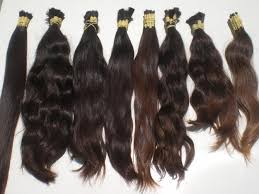
Getting married in the Orthodox Jewish community is often synonymous with buying a wig. Married women have a mitzva to cover their hair and that is usually done by wearing a wig.
Walking in to Orna’s Wig Salon on Reisterstown Road, one is immediately faced with an entire wall covered with wigs. Dark wigs, blond wigs, and all shades in between. Curly wigs, long wigs, wavy wigs, and short wigs. How are all these wigs made? Are they made by hand, by machine, here in Baltimore or overseas?
Orna has her own line of wigs called “Orna Wigs,” and she is also an expert in wig repair. I asked her to explain how the hair on a wig goes from the head of a woman in Brazil to the head of a woman here in Baltimore.
WWW: How do you get the hair for the wigs?
Orna: All the hair we use comes from suppliers. Many countries have suppliers who buy hair from people in their country and then sell the hair to wig makers. I have connections with suppliers whom I trust to sell me high-quality hair. Different countries have hair of different quality. For example, Chinese people have very straight, thin hair, which wouldn’t make a quality wig. Most of our blond or light-colored hair comes from Russia. We don’t buy hair from India anymore.
WWW: What does the term “European hair” refer to? Does it mean hair from European countries?
Orna: No, “European hair” refers to hair that is 100 percent virgin hair, unprocessed and untreated. It can come from many different countries, including Brazil and Russia.
WWW: Does each wig need just one head of hair?
Orna: No, each wig requires the hair of four or five people.
WWW: How do you buy hair?
Orna: Hair is sold by the kilo. It has to be at least 12 inches long in order to be sold. I usually order 30 kilos of hair at a time. Virgin, never-processed hair can cost $1,600 to $2,500 a kilo. That means that it wasn’t colored or chemically treated. Each kilo of hair can make about three wigs, one long, one medium, and one short.
WWW: Once you buy the hair, can it be made into a wig right away?
Orna: No, then we have to clean the hair and separate it into different lengths.
WWW: Do you make the wigs here?
Orna: I know how to make a wig and I’ve done it for a few people, but in general the wigs are made in a factory in China. Labor is too expensive in the United States to make the wigs here. I give them instructions about how I want the wigs to be made and they follow the instructions. As an example, making a skin part can take about 20 hours, as it is made by hand. The hair is sewn onto a weft and then the weft is sewn on to the cap. Baby hairs are sewn onto the front of the wig using a ventilating needle.
WWW: I’ve purchased my last few wigs from you. I like them because they have body and aren’t so flat on top. Does that have anything to do with you, or is it just coincidence?
Orna: I explain to the factories how I want my wigs to be designed. What you’re talking about is called depth. I’m very careful to give clear instructions so that the wigs will be manufactured according to my specifications.
WWW: We used to wear synthetic hair wigs, but today most people wear human hair wigs. What’s changed?
Orna: Human hair wigs can last for much longer. A good wig with quality hair can last at least three or four years.
WWW: Thank you, Orna, for teaching me a little bit about how wigs are made.






